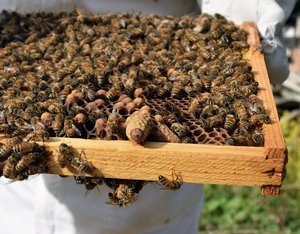Raising a New Queen

Normally, the honeybee colony contains only one queen. Without her the colony would cease to exist because the workers die of old age after six weeks in the summer (six months in the winter). What happens when the queen leaves the hive, or nest, with some workers to start a new nest somewhere else? Sometime before she leaves, the workers somehow sense that the queen will soon leave. They respond by building a number of queen cells and the queen lays an egg in each one. If the queen is lost suddenly, due to an accident or disease, there is no chance for the queen to lay eggs in queen cells. In this case, the workers change a worker cell that already has an egg, or a larva less than three days old, into a larger, longer queen cell. Larvae in queen cells are fed only royal jelly — no pollen and nectar are added to their food. As a result, a queen develops instead of a worker. Scientists have studied royal jelly to try to find out what food materials in it make a larva become a queen bee. Remember that a queen bee has a different structure and behavior from a worker bee. (See Study Print 5). Nobody has yet discovered what special food materials are in royal jelly.
About four days after hatching, a queen larva will be large enough to fill most of the cell. Workers then cap the cell and the larva spins a cocoon around itself and changes into a pupa. Only 16 days after the egg was laid, a new adult queen breaks her way out of the pupa skin and chews her way out through the bottom tip of her cell. The new queen quickly begins to search for other queen cells. When she finds them, she chews a small hole in the wall of each one, and stings and kills the developing “rival" queen. If two queens come out of their cells at the same time, they fight until one is killed. This happens because a new queen will attack any object, even another worker, that carries the odor of another queen. When the new queen is about 7-10 days old, she makes her first flight. This is her mating flight and it lasts only about 13 minutes. During this time, she mates with at least seven drones, or male bees. Then she returns to the colony to begin her life of laying eggs. It is interesting that worker bees do not make any queen cells or raise any queens except when the queen is lost or about to leave the colony. This is thought to be because a queen normally produces enough queen odors that prevent the workers from making new queen cells. For example, if queen scent is placed on a cork, workers will not make queen cells even when there is no queen in the colony.
Man has learned how to “trick" bees into raising large numbers of queen bees in one colony. The colony’s queen is first removed. Then the colony is increased in size by “borrowing" workers from other colonies and feeding them lots of honey or sugar syrup. Into this “super" colony are placed 50-100 artificial, or man-made queen cells. The cells are made from beeswax and shaped exactly as workers shape real queen cells. A worker larva about one day old is gently removed from a worker cell and placed in each artificial queen cell. Thus, many queens are raised by the worker bees in the “super colony". Once the queen cells have been capped, they are removed and the queens allowed to emerge in separate cages in the incubator to prevent them from fighting and killing each other. Queens reared in this way are used to replace old queens in other hives or to start new colonies.
The Bees section was created with special thanks to Louis Juers (Arizona State Parks & Trails) for providing information used in this section. Additional information and digital materials were obtained from some of the following organizations. We would like to thank them for all their dedication and hard work within their profession.
|









